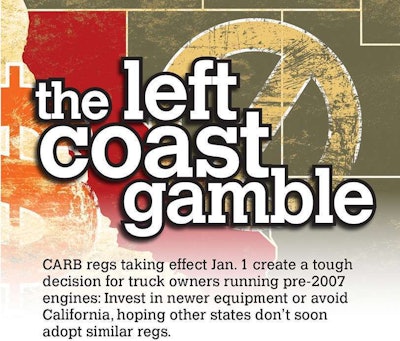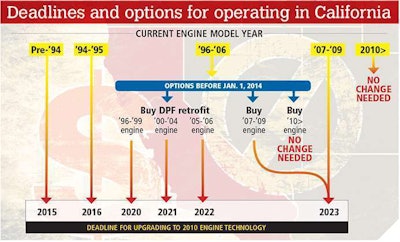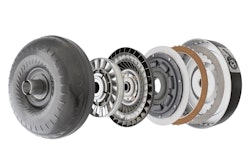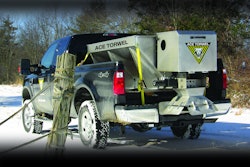
But further extensions are not in the offing, says CARB Public Information Officer Karen Caesar. Come Jan. 1, she notes, “the first [particulate matter] filter is now required” for small fleets with 1996-2006 model-year equipment under the upgrade requirements of the agency’s Statewide Truck and Bus Rule. For owners of trucks powered by 1996-2006 model-year engines, this means it’s compliance crunch time if you live in or run in California on a regular basis.

The small fleet phase-in option is something of a “sweet spot” for smaller trucking companies in CARB requirements, says Joe Rajkovacz, government affairs director at the California Construction Trucking Association.
Still, CCTA continues to pursue federal litigation currently on appeal in the Ninth Circuit over CARB’s aggressive regulation of the industry. The industry needs to know “if environmental legislation trumps all federal law,” Rajkovacz says. “Buying a truck and keeping it for many years – and in some cases into decades – has always been one of the strengths of small-business trucking.”
The initial decision of the Sacramento circuit court against CCTA was not based on the merits of the argument, Rajkovacz says. Rather, Natural Resources Defense Council lawyers, acting on behalf of CARB, got a somewhat procedural ruling because CCTA hadn’t included the U.S. Environmental Protection Agency as a target of the lawsuit with CARB: EPA approved CARB’s State Implementation Plan for the Truck and Bus Rule, hence it federalized the rule, CARB/NRDC lawyers argued.
The possibility that the suit will fail on appeal – and the court ultimately will give CARB the go-ahead on the diesel engine restrictions – has watchers like Bill McClusky, maintenance consultant for business services provider ATBS, urging truck owners to consider the regulations as permanent. Hoping it just goes away is not the best strategy.
If staying out of California is your plan, know that it’s something of a gamble in terms of the rest of the country. Under the Clean Air Act, California has special status in relation to EPA: The state holds the right to develop its own more stringent standards, which other states then can adopt or not. As regards clean air laws, “what starts in California ends up running across the United States,” McClusky says. “There are 20-some other states that have expressed their intent to adopt the CARB regulations. … My opinion is it will happen – it could be six months or six years from now.”

While 2007-09 model-year engines will keep owners compliant with the Truck and Bus Rule through 2022, “from a fuel mileage perspective, they are some of the worst,” says McClusky. “With 2010 engines and later, all that changed, allowing them much better fuel mileage. If I’m going to be in the industry at least another 10 years, the benefit of having that fuel mileage will be great. If you’re only in it for another three years, maybe jump into a 2007-09 and finish out your time, or make the gamble that other states won’t adopt [CARB regulations].”
McClusky and others, however, acknowledge used trucks with 2010 engine technology are hard to come by – and none too cheap. “This whole regulation is driving up prices on [CARB]-compliant trucks,” McClusky says.
Comments on OverdriveOnline.com, a Randall-Reilly trucking website, suggest CARB just doesn’t have the manpower or the will to enforce the engine requirements. “They have only 100 enforcement people to take care of this debacle,” an anonymous commenter noted under a June story on the yearend upgrade requirements, urging operators to just keep running in the state. “The chances of getting caught are like playing the lottery. Everyone here is still running their junk.”

According to the numbers, California began enforcement under a new Statewide Truck and Bus program in 2012, opening a total of 400 investigations with just $20,325 collected in various penalties. In the field operations-based portion of that program, however, 2,802 inspections were completed that year, with 298 violation notices issued to the tune of $171,050 collected in noncompliance penalties, or about $600 per noncompliant case.
In 2012, the inspection program’s first year, it was the second-most lucrative program overall measured per inspection. Keep in mind, too, these statistics come from a year in which only about 30 percent of the total number of trucks on the highway, says Rajkovacz, fell under one or another of the DPF retrofit or upgrade requirements – non-small fleet equipment of model years 1996-2004.
Next year, that will include all the small-fleet trucks plus 2005-06 trucks. Given the large pre-buy of 2006 model-year engines, many of which ended up in 2007 model-year trucks, Rajkovacz estimates somewhere between 70 and 90 percent of the diesel vehicle population will be exposed to the regulation.
Keeping that $600/violation average figure in mind, the possibilities are green indeed when it comes to generating revenue for the state. Caesar says penalties levied for individual violations can range from $300 to $10,000. CARB also takes into account the history of the violating business. “If a company is a repeat offender, having flouted CARB rules in the past, fines can be toward the higher end,” she says.
Conditions the board must take into account in enforcement actions are spelled out in California legislation S.B. 1402, posted on the agency’s website, and they likewise include a provision for consideration of the financial burden the penalty would place upon the defendant. Resolution procedures include an “opportunity to discuss,” so if you are unlucky enough to be nabbed, you might negotiate a lower penalty.
Editor’s note: Todd Dills is the senior editor of Overdrive, a Randall-Reilly publication. Details on all CARB requirements can be found via the agency’s Truck Stop portal; visit arb.ca.gov/truckstop. EW










